Android Bluetooth Example
If we want to exchange data between different devices through our application, Bluetooth is a way for wirelessly connection between devices that support Bluetooth. Android system provides us Bluetooth APIs, from which we can:
- Find paired Bluetooth devices
- Search for other Bluetooth devices
- Connect to one or more of these devices
- Receive and Transfer data
In our example we are going to create an application which activates and deactivates Bluetooth, finds the paired Bluetooth devices and scans for discovered Bluetooth devices.
For this tutorial, we will use the following tools in a Windows 64-bit platform:
- JDK 1.7
- Eclipse 4.2 Juno
- Android SDK 4.4
1. Create a New Android Application Project
Open Eclipse IDE and go to File → New → Project → Android Application Project.
Specify the name of the application, the project and the package and then click Next.
In the next window, the “Create Activity” option should be checked. The new created activity will be the main activity of your project. Then press Next button.
In “Configure Launcher Icon” window you should choose the icon you want to have in your app. We will use the default icon of android, so click Next.
Choose the “Blank Activity” option and press Next.
Specify the name of the new Activity and the name of the layout description of your app. The .xml file for the layout will automatically be created in the res/layout folder. Finally, press Finish.
Now that the project is created, you can see the final structure of the project in the image below.
2. Create the layout of the Main Activity
As we mentioned, our app will do three basic functions. We will add two Buttons in order to enable and disable Bluetooth. Moreover we will put two Buttons, one for the paired and the other for the enabled Bluetooth devices. Also to show the Bluetooth devices in each situation, we will add a ListView.
Open res/layout/activity_main.xml and go to the respective xml tab. Then paste the code below.
activity_main.xml:
<RelativeLayout xmlns:android="http://schemas.android.com/apk/res/android"
xmlns:tools="http://schemas.android.com/tools"
android:layout_width="match_parent"
android:layout_height="match_parent"
tools:context=".MainActivity" >
<TextView
android:id="@+id/text"
android:layout_width="wrap_content"
android:layout_height="wrap_content"
android:textAppearance="?android:attr/textAppearanceLarge"
android:text="@string/Text" />
<LinearLayout
android:layout_width="match_parent"
android:layout_height="wrap_content"
android:orientation="horizontal"
android:layout_marginTop="30dp" >
<Button
android:id="@+id/turnOn"
android:layout_width="wrap_content"
android:layout_height="wrap_content"
android:text="@string/on" />
<Button
android:id="@+id/turnOff"
android:layout_width="wrap_content"
android:layout_height="wrap_content"
android:text="@string/off" />
</LinearLayout>
<LinearLayout
android:layout_width="match_parent"
android:layout_height="wrap_content"
android:orientation="vertical"
android:layout_marginTop="80dp" >
<Button
android:id="@+id/paired"
android:layout_width="wrap_content"
android:layout_height="wrap_content"
android:text="@string/List" />
<Button
android:id="@+id/search"
android:layout_width="wrap_content"
android:layout_height="wrap_content"
android:text="@string/Find" />
<ListView
android:id="@+id/listView1"
android:layout_width="fill_parent"
android:layout_height="200dp" >
</ListView>
</LinearLayout>
</RelativeLayout>
Also, we have to specify the texts in the stings.xml file, so go to res/values/strings.xml and specifically to the xml tab. Then paste the following.
strings.xml:
<?xml version="1.0" encoding="utf-8"?>
<resources>
<string name="app_name">BluetoothTest</string>
<string name="action_settings">Settings</string>
<string name="Text">Status: -</string>
<string name="on">Turn On</string>
<string name="off">Turn Off</string>
<string name="List">List paired Devices</string>
<string name="Find">Search new Devices / Cancel</string>
</resources>
3. Code the Main Activity
To interact with Bluetooth, BluetoothAdapter class should be used, so getDefaultAdapter() is called to take an instance of this object class. To turn on Bluetooth, firstly we should check if BluetoothAdapter is already enabled. If not, startActivityForResult() method with the ACTION_REQUEST_ENABLE action Intent is called. Notice that the second parameter of startActivityForResult() method, is an integer and is set greater than 0, so the system goes back to our implementation of onActivityResult() method of the Activity. In contrast, we call disable() method in order to turn off Bluetooth.
A very important functionality in Bluetooth, is to scan and search for devices that are discoverable and can be accessed in a local area. When we say discoverable, we mean that a device is enabled and its information is shared and visible. Before the discovering procedure it is good to query the set of paired devices, because the desirable device may be already known. Paired devices are previously connected devices, where the information is stored and reused by the Bluetooth APIs. To set the paired devices, getBondedDevices() is called, so we can find out all the BluetoothDevices.
For the performance of device discovery, we call startDiscovery() method. To receive all the information of the BluetoothDevices that are discovered, we should register a BroadcastReceiver for the Intent with ACTION_FOUND. It is recommended to cancel the discovery procedure because BluetoothAdapter consumes many resources, so cancelDiscovery() is used for this reason. Also in our example, we unregister the previously registered BroadcastReceiver and remove all its filters, by calling unregisterReceiver() in the onDestroy() method of our Activity.
Open src/com.javacodegeeks.android.bluetoothtest/MainActivity.java file and paste the following code.
MainActivity.java:
package com.javacodegeeks.android.bluetoothtest;
import android.os.Bundle;
import android.app.Activity;
import android.bluetooth.BluetoothAdapter;
import android.bluetooth.BluetoothDevice;
import android.content.BroadcastReceiver;
import android.content.Context;
import java.util.Set;
import android.content.Intent;
import android.content.IntentFilter;
import android.view.View;
import android.view.View.OnClickListener;
import android.widget.ArrayAdapter;
import android.widget.Button;
import android.widget.ListView;
import android.widget.TextView;
import android.widget.Toast;
public class MainActivity extends Activity {
private static final int REQUEST_ENABLE_BT = 1;
private Button onBtn;
private Button offBtn;
private Button listBtn;
private Button findBtn;
private TextView text;
private BluetoothAdapter myBluetoothAdapter;
private Set<BluetoothDevice> pairedDevices;
private ListView myListView;
private ArrayAdapter<String> BTArrayAdapter;
@Override
protected void onCreate(Bundle savedInstanceState) {
super.onCreate(savedInstanceState);
setContentView(R.layout.activity_main);
// take an instance of BluetoothAdapter - Bluetooth radio
myBluetoothAdapter = BluetoothAdapter.getDefaultAdapter();
if(myBluetoothAdapter == null) {
onBtn.setEnabled(false);
offBtn.setEnabled(false);
listBtn.setEnabled(false);
findBtn.setEnabled(false);
text.setText("Status: not supported");
Toast.makeText(getApplicationContext(),"Your device does not support Bluetooth",
Toast.LENGTH_LONG).show();
} else {
text = (TextView) findViewById(R.id.text);
onBtn = (Button)findViewById(R.id.turnOn);
onBtn.setOnClickListener(new OnClickListener() {
@Override
public void onClick(View v) {
// TODO Auto-generated method stub
on(v);
}
});
offBtn = (Button)findViewById(R.id.turnOff);
offBtn.setOnClickListener(new OnClickListener() {
@Override
public void onClick(View v) {
// TODO Auto-generated method stub
off(v);
}
});
listBtn = (Button)findViewById(R.id.paired);
listBtn.setOnClickListener(new OnClickListener() {
@Override
public void onClick(View v) {
// TODO Auto-generated method stub
list(v);
}
});
findBtn = (Button)findViewById(R.id.search);
findBtn.setOnClickListener(new OnClickListener() {
@Override
public void onClick(View v) {
// TODO Auto-generated method stub
find(v);
}
});
myListView = (ListView)findViewById(R.id.listView1);
// create the arrayAdapter that contains the BTDevices, and set it to the ListView
BTArrayAdapter = new ArrayAdapter<String>(this, android.R.layout.simple_list_item_1);
myListView.setAdapter(BTArrayAdapter);
}
}
public void on(View view){
if (!myBluetoothAdapter.isEnabled()) {
Intent turnOnIntent = new Intent(BluetoothAdapter.ACTION_REQUEST_ENABLE);
startActivityForResult(turnOnIntent, REQUEST_ENABLE_BT);
Toast.makeText(getApplicationContext(),"Bluetooth turned on" ,
Toast.LENGTH_LONG).show();
}
else{
Toast.makeText(getApplicationContext(),"Bluetooth is already on",
Toast.LENGTH_LONG).show();
}
}
@Override
protected void onActivityResult(int requestCode, int resultCode, Intent data) {
// TODO Auto-generated method stub
if(requestCode == REQUEST_ENABLE_BT){
if(myBluetoothAdapter.isEnabled()) {
text.setText("Status: Enabled");
} else {
text.setText("Status: Disabled");
}
}
}
public void list(View view){
// get paired devices
pairedDevices = myBluetoothAdapter.getBondedDevices();
// put it's one to the adapter
for(BluetoothDevice device : pairedDevices)
BTArrayAdapter.add(device.getName()+ "\n" + device.getAddress());
Toast.makeText(getApplicationContext(),"Show Paired Devices",
Toast.LENGTH_SHORT).show();
}
final BroadcastReceiver bReceiver = new BroadcastReceiver() {
public void onReceive(Context context, Intent intent) {
String action = intent.getAction();
// When discovery finds a device
if (BluetoothDevice.ACTION_FOUND.equals(action)) {
// Get the BluetoothDevice object from the Intent
BluetoothDevice device = intent.getParcelableExtra(BluetoothDevice.EXTRA_DEVICE);
// add the name and the MAC address of the object to the arrayAdapter
BTArrayAdapter.add(device.getName() + "\n" + device.getAddress());
BTArrayAdapter.notifyDataSetChanged();
}
}
};
public void find(View view) {
if (myBluetoothAdapter.isDiscovering()) {
// the button is pressed when it discovers, so cancel the discovery
myBluetoothAdapter.cancelDiscovery();
}
else {
BTArrayAdapter.clear();
myBluetoothAdapter.startDiscovery();
registerReceiver(bReceiver, new IntentFilter(BluetoothDevice.ACTION_FOUND));
}
}
public void off(View view){
myBluetoothAdapter.disable();
text.setText("Status: Disconnected");
Toast.makeText(getApplicationContext(),"Bluetooth turned off",
Toast.LENGTH_LONG).show();
}
@Override
protected void onDestroy() {
// TODO Auto-generated method stub
super.onDestroy();
unregisterReceiver(bReceiver);
}
}
4. Set the permissions
We have to declare the permissions in the AndroidManifest.xml file of our project. For this reason we add BLUETOOTH permission if we want to use any of the Bluetooth features. Also we should add BLUETOOTH_ADMIN permission, in order to discover other devices.
Open AndroidManifest.xml file and go to the respective xml tab. Then paste the following.
AndroidManifest.xml:
<?xml version="1.0" encoding="utf-8"?>
<manifest xmlns:android="http://schemas.android.com/apk/res/android"
package="com.javacodegeeks.android.bluetoothtest"
android:versionCode="1"
android:versionName="1.0" >
<uses-sdk
android:minSdkVersion="8"
android:targetSdkVersion="19" />
<uses-permission android:name="android.permission.BLUETOOTH"/>
<uses-permission android:name="android.permission.BLUETOOTH_ADMIN"/>
<application
android:allowBackup="true"
android:icon="@drawable/ic_launcher"
android:label="@string/app_name"
android:theme="@style/AppTheme" >
<activity
android:name="com.javacodegeeks.android.bluetoothtest.MainActivity"
android:label="@string/app_name" >
<intent-filter>
<action android:name="android.intent.action.MAIN" />
<category android:name="android.intent.category.LAUNCHER" />
</intent-filter>
</activity>
</application>
</manifest>
We should mention that if we have to add BLUETOOTH_ADMIN permission, the declaration of BLUETOOTH permission is obligatory.
5. Run the application
To run the application we can’t use the Android emulator, so we have to run the app from our Android device via Eclipse.
Connect your Android device with your pc through USB. Go to Settings → Applications → Development path and enable USB debugging option.
Back to Eclipse, right click on our project → Run as → Run Configurations.
In the popup window choose the current project, go to the Target tab and choose “Always prompt to pick device” option, as you can see below. Then click Run.
Finally choose the running Android device and press OK.
The app will be loaded in your Android device, as you can see in the image below.
Lets press “Turn On” button in order to activate Bluetooth. A popup window will be shown as you can see below.
If we choose “No” option the status will be “Disabled” as the Bluetooth will not be activated.
Select “Yes” option and Bluetooth will be turned on.
Now click “List paired Devices”, in order to see the paired Bluetooth devices that we had been connected in the past. You can see the list in the next picture. Also notice that the status is now “Enabled” and a appropriate icon is appeared, because Bluetooth is active.
If we click the “Search new Devices / Cancel” button, the list of the enabled Bluetooth devices will be shown. If we press again the button, the discovery of these devices will be canceled.
Finally, press “Turn off” button. The Bluetooth is disabled and the default icon for Bluetooth is disappeared, as you can see in the next image.
Download Eclipse Project
This was an example of Bluetooth in Android. Download the Eclipse Project of this example: BluetoothTest.zip


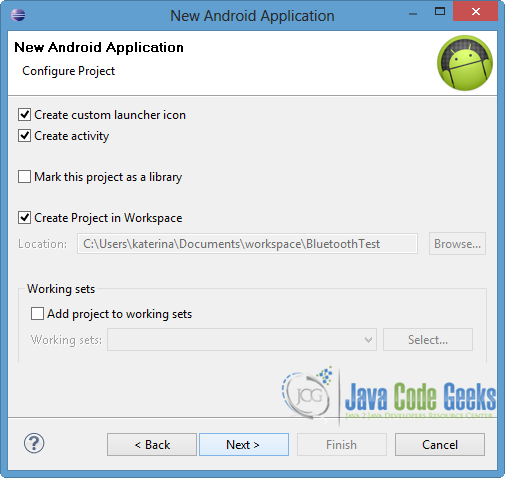

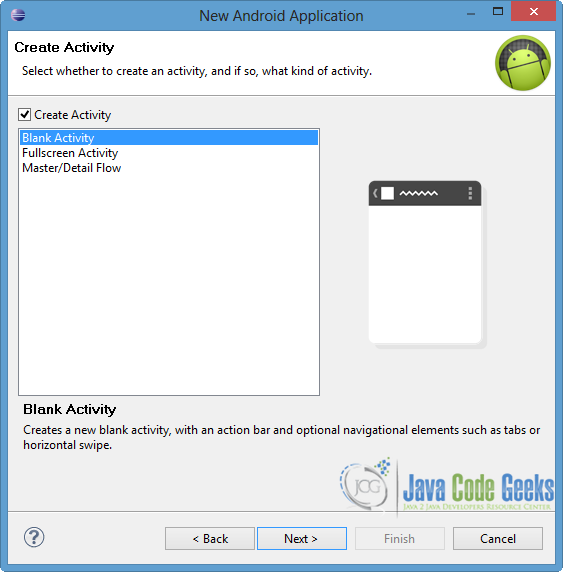
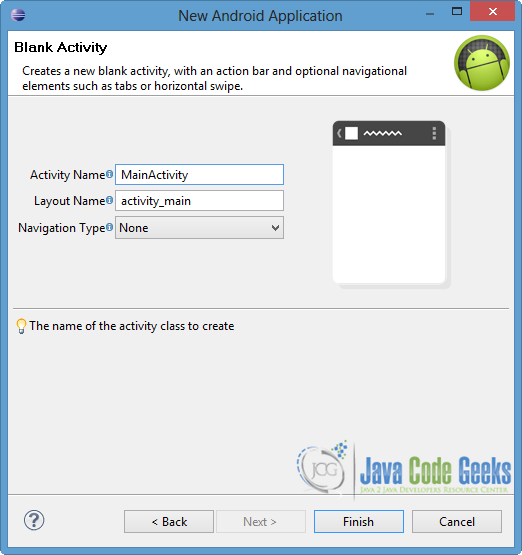
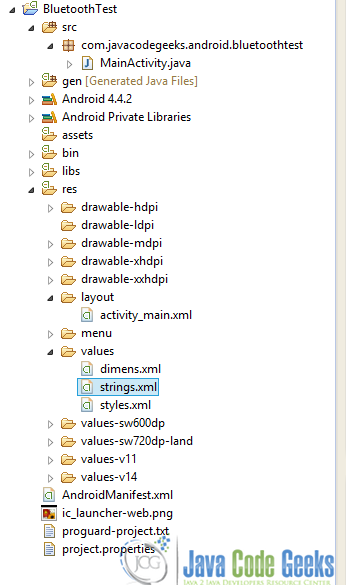
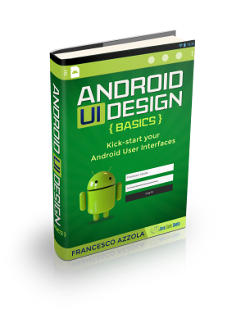
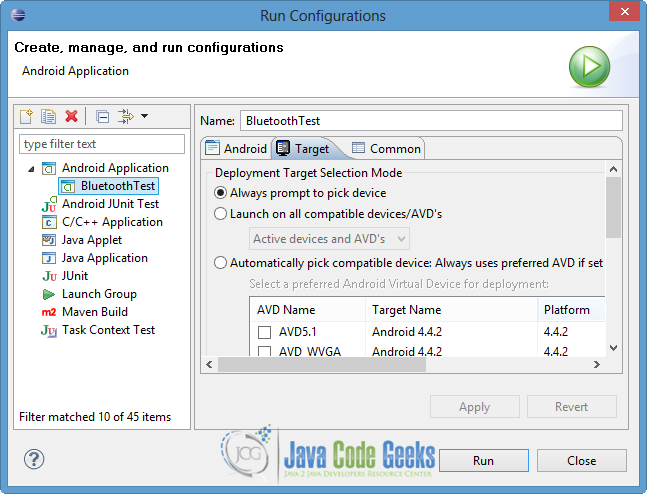
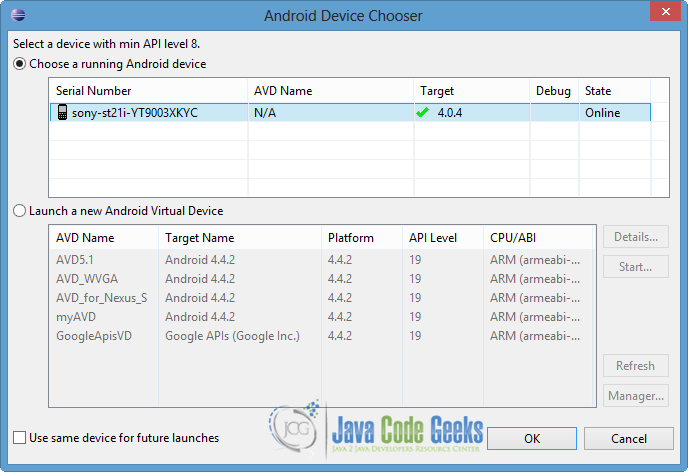
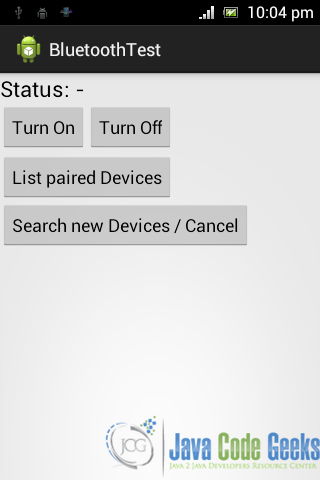

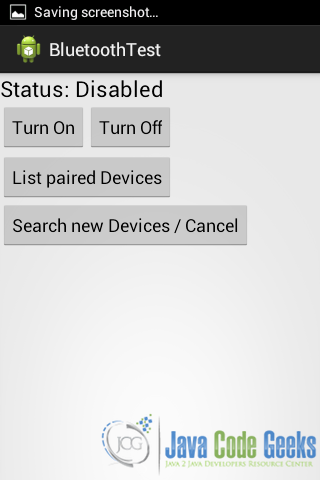


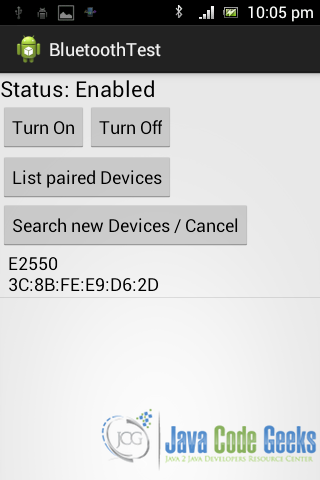
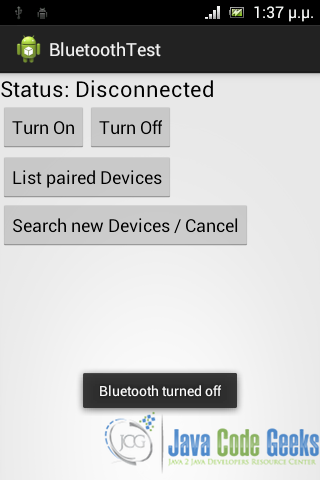

how to download
It is very nice tutorial regarding Bluetooth development but can you update the code for the Android version 6.0 as it asks for location permission.
But how to read bluetooth data?
It’s a good example. But did you actually run this code. It should throw a NullpointerException if the device does not support Bluetooth.
simple_list_item_1 where did you declare
Let me know simple_list_item_1 where it is declared?
Bluetooth scanning for new devices is not working